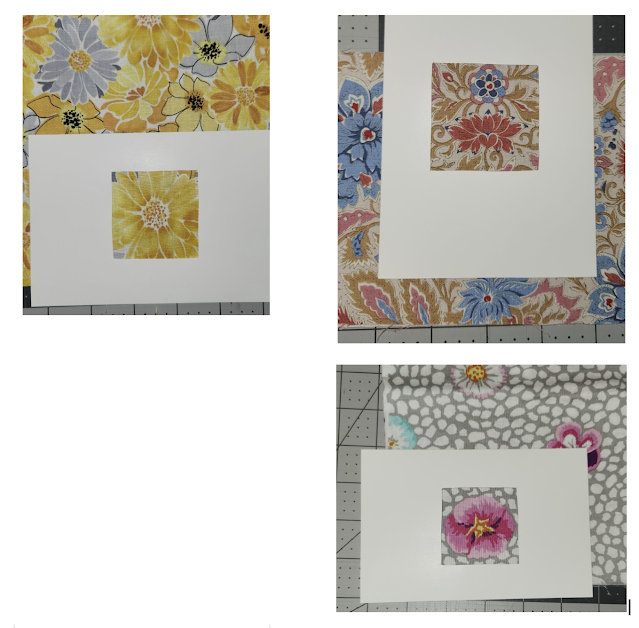 |
| sample completed blocks |
The Block
- The Economy Block, if you are unfamiliar, is a square in a square in a square.
- I am using foundation paper piecing. If you’ve never used this technique, this block
is an excellent introduction to FPP. - Your completed size for this block is 4.5”.
- This month is scrap friendly. The largest piece of fabric you will need is 3.5” square.
The Inspiration
There are a few things that have been on my list of quilting to-do’s:
- Fussy cutting. I like the look but hate the waste, so how to do it without using mass amounts of fabric?
- Small blocks. So much of what I do has large blocks. My first full-sized quilt was a disappearing nine-patch
made with 10” pieces (that’s a 29” block). I want to piece something that is smaller. - Modern white space. Although I like the idea of small, I also prefer more modern quilts, so I know I need
to sash or add solids to make a whole quilt.
A combination of small fussy-cut center Economy Blocks fits my first two inspirations. White or grey or some other colour of sashing, yet to be determined, will meet the third.

Tools
You will need the standard quilting tools, with the following tools being helpful.- Scissors - both paper and fabric
- A printer to print the template.
- Spray starch.
- A fabric glue stick, plain glue stick, or a pin or two for holding the pieces together.
Since you sew on the paper side, you need something to hold the fabric in place. - A 4.5” square for trimming the final block, but any ruler for trimming will do.
Fabric choice.
You will need three fabrics:
- Something to fussy cut. A floral, geometric, small or medium print with a distinct
motif to focus the central block. An animal is okay as long as it’s a grown-up print
rather than something cartoonish or for kids. - A solid or something that reads solid for the second row.
- A small overall print for the third row.
See my fabric pull at the end of the post.
Colour
All three of your fabrics should be
- In the same colour
- Should be a ROY G BIV (aka red, orange, yellow, green, blue, indigo, violet) colour
- Should blend. Contrast is not required, but I understand that there may be some lighter and darker fabrics in the same colour range.
- No neutrals, so no white, black, grey, or cream.
- No neons as the primary colour. Bright is nice but neon is too bright for me.
- It’s okay if there is a bit of neutral or neon in the pattern or in the background.
- Modern prints are good, and if you have non-modern scraps to get rid of,
those work too.
Fussy Cutting
If you are familiar with fussy cutting, skip to the pattern.
If you are new to fussy cutting, you can see an explanation of the process and some of my decisions at the end of the post. There is also a video in the Resources section at the end.
The Pattern
The Economy Block uses the foundation paper piecing technique. This method allows
you to sew pieces of fabric along the bias or in intricate patterns.
For more information on how to FPP, check out the resources at the end.
General Sewing Notes
- Reduce your stitch length to 1.5-1.8. This makes the paper easier to remove later.
- Always start and stop about ¼” beyond the solid sew line.
- The next patch will secure the seam ends so it is not necessary to back stitch.
- You may end up trimming off the backstitch since the block will be trimmed.
- I press to set the seam, then press the pieces open on the right side.
- You always press the sides out on an Economy block.
Prepare the template:
|
|
|
|
|
|
Tips to line up the fabric on the template.
Foundation paper piecing requires lining up the fabric on one side of the template, then sewing it on the other side. You are sewing somewhat blind.
Many people hold the template and fabric up to the light or use a lightbox (or computer screen, tablet or phone will work in a pinch or at night). But the Economy Block is a simple block and so I like to fold my template.
Prepare and cut the Fabric
Here are some of the fabrics I prepared
I starched everything before cutting since triangles are prone to stretch along the bias.
Fabric B & C blocks are slightly oversized to ensure correct placement and ultimate success.
Sew Fabric B triangles to the Fabric A square
Sew Fabric C triangles to the Fabric B/A square |
||
|
|
||
My Fabric Pull
Here are some images of the fabric pulls.
How I Fussy Cut
If you are not familiar with fussy cutting, all you do is choose a motif that fits in a pleasing way
in your centre square. The image is typically centred with some space between the motif and
what will be the finished edge of the square.
Resources
Photo Credits for Inspiration Collection
Top Row:





















No comments:
Post a Comment